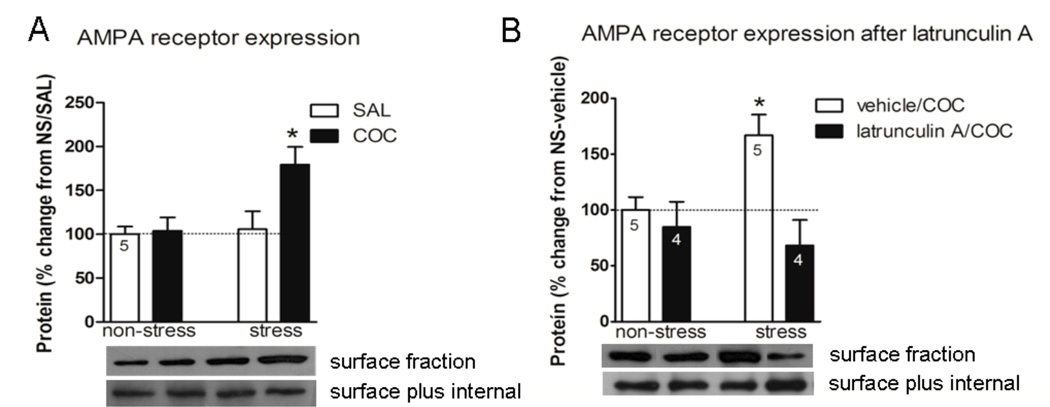Figure 3.
Locomotor activity after cocaine (15 mg/kg i.p.) in rats pretreated with latrunculin A (0.5 µg) or vehicle (DMSO 1 %) into the NAc, 3 weeks after repeated immobilization stress. After 1 h habituation to test cages, the animals were injected with latrunculin A (n=6/group) or vehicle (n=7/group) intra-accumbens and 5 min later with saline or cocaine i.p. after which locomotor activity was monitored for 2 h. Values represent the mean ± SEM of horizontal photocell counts over 10 min periods. Total photocell counts over 120 min were shown as mean ± SEM. A, Time-course of locomotor activity was analyzed by a two-way ANOVA (non-stress/stress × latrunculin A/vehicle) with repeated measures over time: time F(17,374)=21.41, p<0.001; stress F(1,374)=18.05, p<0.001; stress × treatment F(1,22)=8.57, p=0.008; stress × treatment × time F(17,374)=6.03, p=0.008. * p<0.05 compared with all the remaining groups (non-stress-vehicle, non-stress-latrunculin A and stress-latrunculin A). # p<0.05 compared with non-stress-vehicle group. Comparisons between groups were at the same time point by the Tukey´s test. Arrow indicates 15 mg/kg cocaine i.p. injection. B, Total horizontal photocell counts 120 min after the cocaine injection was analyzed by a two-way ANOVA (non-stress/stress × latrunculin A/vehicle): stress F(1,22)=19.77, p<0.001; stress × treatment F(1,22)=7.36, p=0.013. * p<0.05 compared with all the remaining groups after cocaine injection. C, Location of the microinjection cannula tips in the NAc of rats included in the data analyses. The line drawings are from Paxinos and Watson (Paxinos & Watson, 2009). Numbers to the right indicate millimeters from bregma. Symbols represent the different groups: ○ (non-stress + latrunculin A intra-accumbens); ● (stress + latrunculin A intra-accumbens); □ (non-stress + vehicle intra-accumbens); ■ (stress + vehicle intra-accumbens).

